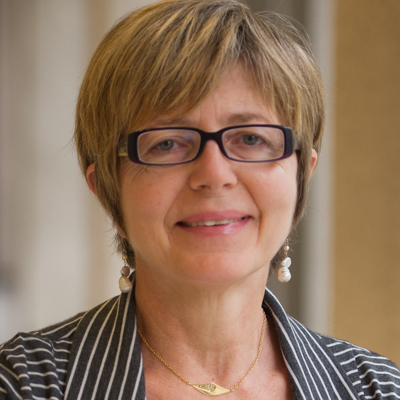Predicting complex organization using simple physical rules
A flock of starlings folds in the sky like a soft cloud, a sheet of cells under the microscope moves as a single cohort and reveals geometric patterns. Can we identify simple laws that govern the organization of such seemingly complex systems? Dr. Cristina Marchetti, the William R. Kenan Professor of Physics at Syracuse University, is a soft matter physicist that studies “active matter” - a term coined to describe assemblies of self-driven entities, such as birds, bacteria, or engineered microswimmers, that take energy from the environment to produce coordinated motion.
One may think that the rich patterns seen in nature must be controlled by complex communication pathways or biochemical signaling. Work by Dr. Marchetti and others over the last two decades has shown, however, that the organization seen on scales from bird flocks to living tissues can emerge from simple physical rules similar to those controlling the organization of familiar inert matter. This provides a new powerful mathematical framework for understanding emergent phenomena in nature, where large groups exhibit coordinated behaviors that are very different from those of the individuals. Using theory and computer simulations, and working closely with colleagues from experimental physics, biology and engineering, Dr. Marchetti develops the minimal rules that are needed to understand such emergent behavior. In other words, can physical rules explain how organizing operates?
Dr. Marchetti’s research brings together ideas and techniques from soft matter and statistical mechanics to describe a broad range of systems that are far from thermal equilibrium. These include subcellular structures that control the motility of individual cells and their ability to sense and respond to forces, the organization of cells into tissues, and mechanical analogues, such as engineered microswimmers and soft-bots. Her interdisciplinary approach provides broad training of students and postdocs at the interface between physics, bioengineering, and biology, while simultaneously developing useful frameworks for future technologies and innovations.
Current research includes:
- Coordinated Cell Migration: Dr. Marchetti is studying the coordinated migration of groups of cells and the sorting of different cell types, which in turn underlie many developmental processes, including embryogenesis, morphogenesis, wound healing, and cancer metastasis. For example, how do skin cells communicate to advance in a highly coordinated fashion and fill the gaps caused by wounds? Working with experimental groups, her team has demonstrated that communication is mediated by mechanical waves, not unlike sound waves, that travel through the cell layer. Unlike sound waves in fluids or solids, mechanical waves in cells are critically mediated by active processes capable of transforming chemical energy into mechanical work. Dr. Marchetti is currently exploring how confinement may be used to drive and control collective migration, with possible applications to tissue engineering.
- Living Fluids: Dr. Marchetti’s group has shown that fluid dynamics can be adapted to model a suspension of bacteria as a living fluid capable of flowing spontaneously, self-organize in complex regular patterns, and exhibit turbulent motion. Dr. Marchetti and her team aim at understanding when this organization occurs spontaneously or is driven by external, often chemical, cues. The next step will be to examine the bacteria’s ability to ``freeze” into biofilms, solid-like collections of micro-orgamisms that form on surfaces and can be prevalent in natural, industrial and hospital settings and can be very difficult to eradicate.
- Active colloids: Inspired by living systems, physicists and chemists have engineered ingenious synthetic microscale swimmers and bots. For instance, when a gold bead half coated with platinum (known as a Janus particle due to its resemblance to the two-faced Roman god Janus) is immersed in a solution rich in hydrogen peroxide, the bead spontaneously, `swims’ resembling a living microorganism. Collections of such self-propelled or active beads spontaneously organize in flocks and swarms. Using theory and computer simulations, Marchetti and her students have predicted this remarkable organization as arising from the competition between motility and crowding. The group is now examining the conditions required for such active beads to drive the assembly and organization of inert particles. This work will pave the way to the engineering of smart materials capable of active-assembly, reconfiguration, and self-healing.
Bio
Dr. Cristina Marchetti grew up in Pavia, Italy, where she attended a public high school focused on the classics, although she also studied science and physics. While she very much enjoyed literature and philosophy, and especially the comparative study of ancient languages from a philological point of view, she was fascinated with math and physics. Therefore, when she attended college she decided to study physics with the goal of pursuing a career in research.
As an undergraduate, Dr. Marchetti had several excellent lab courses and the opportunity to do both experimental and theoretical research in condensed matter physics. It was during this period that she first fell in love with the intellectual challenge of scientific research and the thrill of understanding something new. Between college and graduate school she also taught high school physics as a substitute teacher and realized she had a passion for teaching as well.
Due to these collective experiences, Dr. Marchetti realized that she wanted to pursue a career in academia. However, at the time, there were no Ph.D. programs in Italy nor were there any opportunities for an academic career. Therefore, she obtained a Fulbright Fellowship and went to the University of Florida. There, she started to work on nonequilibrium statistical mechanics that was an area of active research at UF physics at the time.
Since her early training, she had the opportunity to work on soft matter, superconductivity, and now biophysics. Some of those transitions have been triggered by collaborations. She especially enjoys working on soft and living materials because they frequently display emergent collective behavior not seen at the single particle level. This leads to nonlinear, often strongly coupled spatial and temporal fluctuations, that challenge existing theoretical methods, but are also testable in controlled experiments. In addition, soft materials -- critical to many current and future applications -- ranging from solar cells and flexible electronics to soft robots inspired by animal limbs and synthetic organs.
When not conducting research, Dr. Marchetti’s dedication to interdisciplinary graduate education takes up much of her time. She takes her role as a mentor and educator seriously and is motivated to continue to support students in connecting disparate fields to solve problems creatively.
Aside from research, in her free time, Dr. Marchetti enjoys cooking, “but not from recipes!” she clarifies. She explains that improvising in the kitchen keeps her creative. True to her classical education, she also enjoys reading, including poetry, attending the theater, and traveling, when possible with her husband and, if they are visiting from college and grad school, her two daughters as well.
In the News
Syracuse University News
Noozhawk, Santa Barbara News
Simons Foundation News


